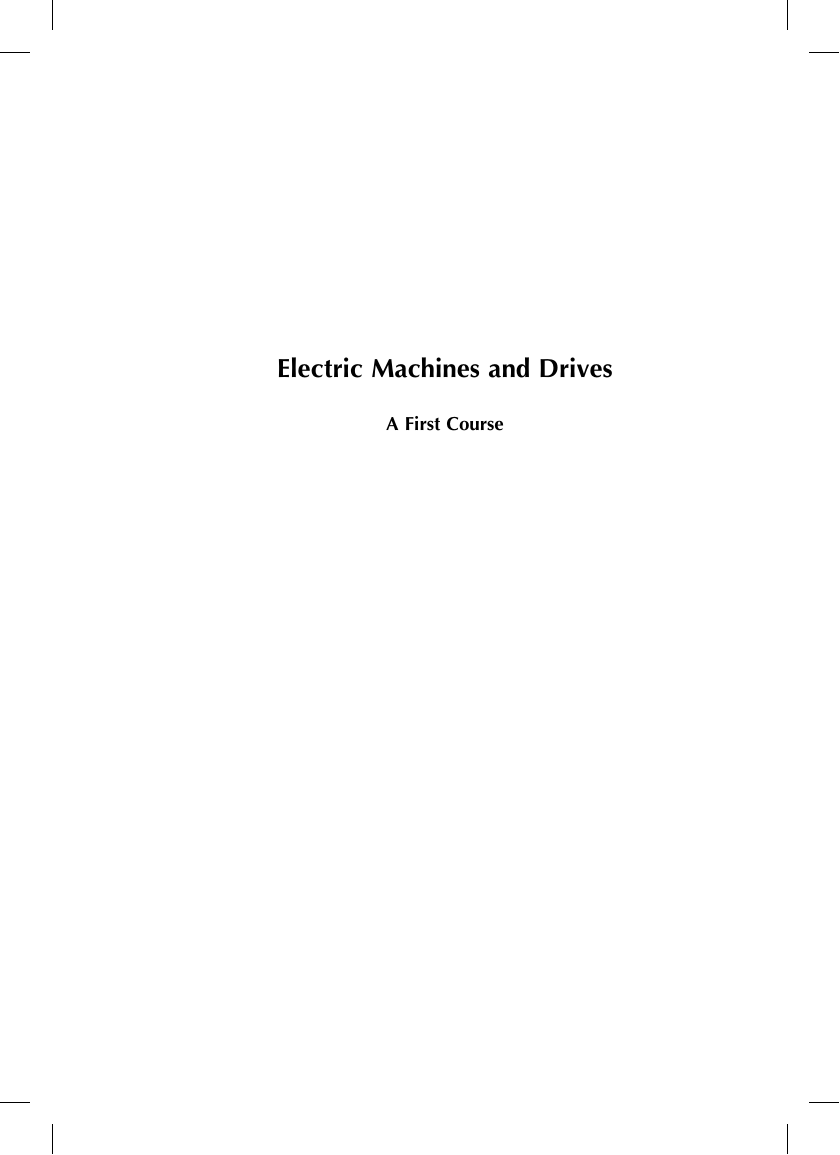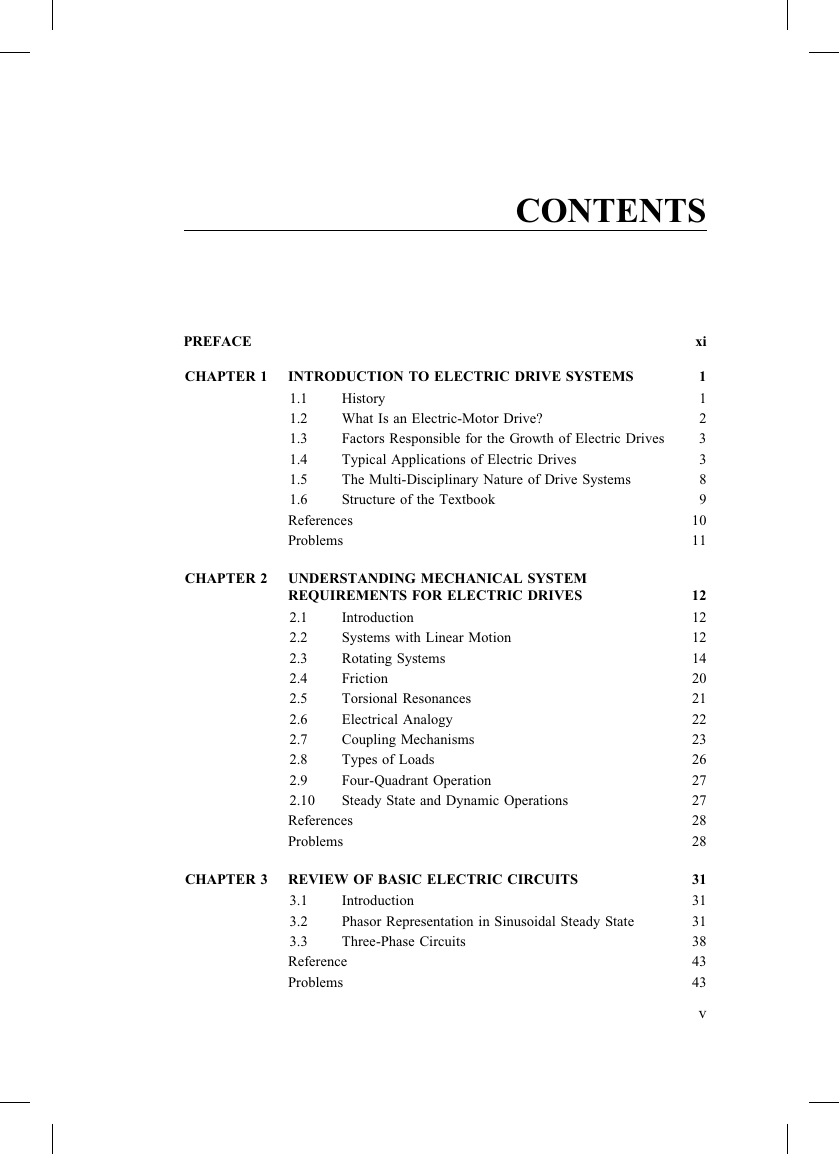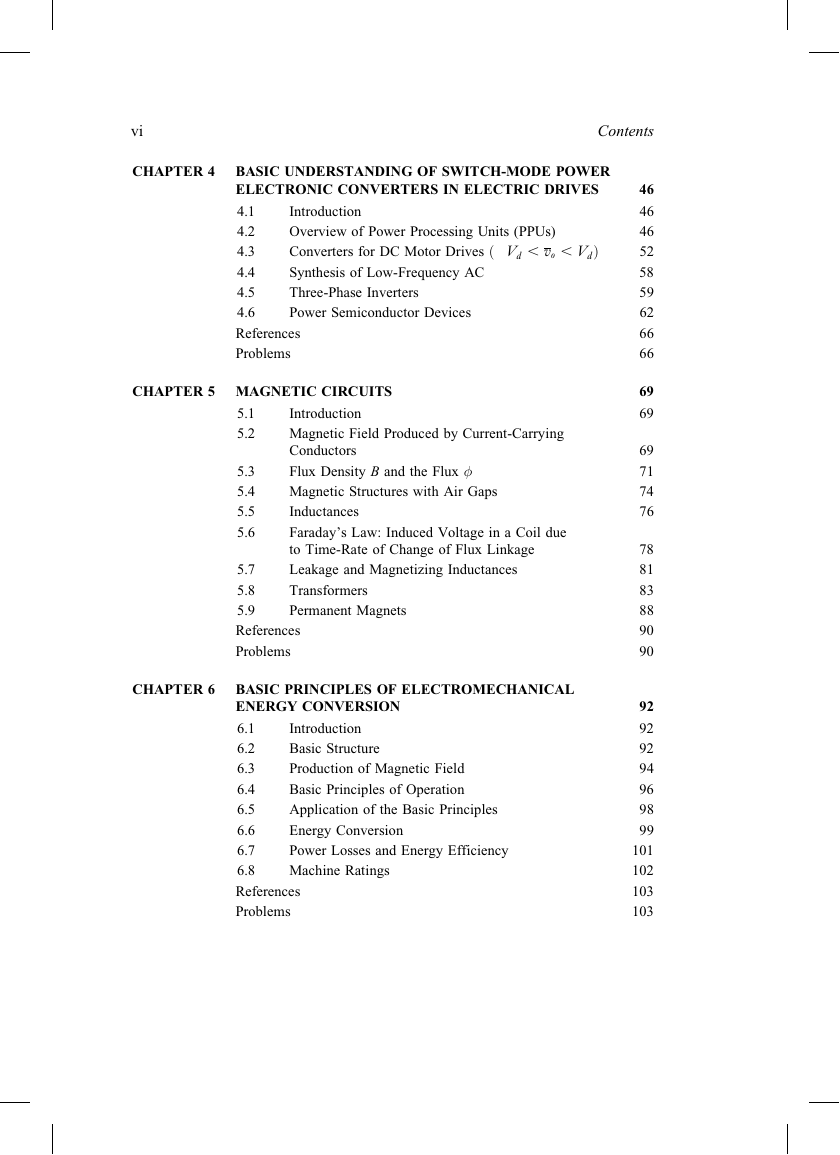Cover Page
Contents
Preface
Chapter 1: Introduction to Electric Drive Systems
1.1: History
1.2: What Is an Electric-Motor Drive?
1.3: Factors Responsible for the Growth of Electric Drives
1.4: Typical Applications of Electric Drives
1.5: The Multi-Disciplinary Nature of Drive Systems
1.6: Structure of the Textbook
References
Problems
Chapter 2: Understanding Mechanical System Requirements for Electric Drives
2.1: Introduction
2.2: Systems with Linear Motion
2.3: Rotating Systems
2.4: Friction
2.5: Torsional Resonances
2.6: Electrical Analogy
2.7: Coupling Mechanisms
2.8: Types of Loads
2.9: Four-Quadrant Operation
2.10: Steady State and Dynamic Operations
References
Problems
Chapter 3: Review of Basic Electric Circuits
3.1: Introduction
3.2: Phasor Representation in Sinusoidal Steady State
3.3: Three-Phase Circuits
Reference
Problems
Chapter 4: Basic Understanding of Switch-Mode Power Electronic Converters in Electric Drives
4.1: Introduction
4.2: Overview of Power Processing Units (PPUS)
4.3: Converters for DC Motor Drives
4.4: Synthesis of Low-Frequency AC
4.5: Three-Phase Inverters
4.6: Power Semiconductor Devices
References
Problems
Chapter 5: Magnetic Circuits
5.1: Introduction
5.2: Magnetic Field Produced by Current-Carrying Conductors
5.3: Flux Density B and the Flux Ø
5.4: Magnetic Structures with Air Gaps
5.5: Inductances
5.6: Faraday's Law: Induced Voltage in a Coil due to Time-Rate of Change of Flux Linkage
5.7: Leakage and Magnetizing Inductances
5.8: Transformers
5.9: Permanent Magnets
References
Problems
Chapter 6: Basic Principles of Electromechanical Energy Conversion
6.1: Introduction
6.2: Basic Structure
6.3: Production of Magnetic Field
6.4: Basic Principles of Operation
6.5: Application of the Basic Principles
6.6: Energy Conversion
6.7: Power Losses and Energy Efficiency
6.8: Machine Ratings
References
Problems
Chapter 7: DC-Motor Drives and Electronically-Commutated Motor (ECM) Drives
7.1: Introduction
7.2: The Structure of DC Machines
7.3: Operating Principles of DC Machines
7.4: DC-Machine Equivalent Circuit
7.5: Various Operating Modes in DC-Motor Drives
7.6: Flux Weakening in Wound-Field Machines
7.7: Power-Processing Units in DC Drives
7.8: Electronically-Commutated Motor (ECM) Drives
References
Problems
Chapter 8: Designing Feedback Controllers for Motor Drives
8.1: Introduction
8.2: Control Objectives
8.3: Cascade Control Structure
8.4: Steps in Designing the Feedback Controller
8.5: System Representation for Small-Signal Analysis
8.6: Controller Design
8.7: Example of a Controller Design
8.8: The Role of Feed-Forward
8.9: Effects of Limits
8.10: Anti-Windup (Non-Windup) Integration
References
Problems and Simulations
Chapter 9: Introduction to AC Machines and Space Vectors
9.1: Introduction
9.2: Sinusoidally-Distributed Stator Windings
9.3: The Use of Space Vectors to Represent Sinusoidal Field Distributions in the Air Gap
9.4: Space-Vector Representation of Combined Terminal Currents and Voltages
9.5: Balanced Sinusoidal Steady-State Excitation (Rotor Open-Circuited)
References
Problems
Chapter 10: Sinusoidal Permanent Magnet AC (PMAC) Drives, LCI- Synchronous Motor Drives, and Synchronous Generators
10.1: Introduction
10.2: The Basic Structure of Permanent-Magnet AC (PMAC) Machines
10.3: Principle of Operation
10.4: The Controller and the Power-Processing Unit (PPU)
10.5: Load-Commutated-Inverter (LCI) Supplied Synchronous Motor Drives
10.6: Synchronous Generators
References
Problems
Chapter 11: Induction Motors: Balanced, Sinusoidal Steady State Operation
11.1: Introduction
11.2: The Structure of Three-Phase, Squirrel-Cage Induction Motors
11.3: The Principles of Induction Motor Operation
11.4: Tests to Obtain the Parameters of the Per-Phase Equivalent Circuit
11.5: Induction Motor Characteristics at Rated Voltages in Magnitude and Frequency
11.6: Induction Motors of Nema Design A, B, C, and D
11.7: Line Start
11.8: Reduced Voltage Starting ("soft start") of Induction Motors
11.9: Energy-Savings in Lightly-Loaded Machines
11.10: Doubly-Fed Induction Generators (DFIG) in Wind Turbines
References
Problems
Chapter 12: Induction-Motor Drives: Speed Control
12.1: Introduction
12.2: Conditions for Efficient Speed Control Over a Wide Range
12.3: Applied Voltage Amplitudes to Keep Bms = Bms, rated
12.4: Starting Considerations in Drives
12.5: Capability to Operate below and above the Rated Speed
12.6: Induction-Generator Drives
12.7: Speed Control of Induction-Motor Drives
12.8: Pulse-Width-Modulated Power-Processing Unit
12.9: Reduction of Bms at Light Loads
References
Problems
Chapter 13: Reluctance Drives: Stepper-Motor and Switched-Reluctance Drives
13.1: Introduction
13.2: The Operating Principle of Reluctance Motors
13.3: Stepper-Motor Drives
13.4: Switched-Reluctance Motor Drives
References
Problems
Chapter 14: Energy Efficiency of Electric Drives and Inverter-Motor Interactions
14.1: Introduction
14.2: The Definition of Energy Efficiency in Electric Drives
14.3: The Energy Efficiency of Induction Motors with Sinusoidal Excitation
14.4: The Effects of Switching-Frequency Harmonics on Motor Losses
14.5: The Energy Efficiencies of Power-Processing Units
14.6: Energy Efficiencies of Electric Drives
14.7: The Economics of Energy Savings by Premium-Efficiency Electric Motors and Electric Drives
14.8: The Deleterious Effects of The PWM-Inverter Voltage Waveform on Motor Life
14.9: Benefits of Using Variable-Speed Drives
References
Problem
Index
















 2023年江西萍乡中考道德与法治真题及答案.doc
2023年江西萍乡中考道德与法治真题及答案.doc 2012年重庆南川中考生物真题及答案.doc
2012年重庆南川中考生物真题及答案.doc 2013年江西师范大学地理学综合及文艺理论基础考研真题.doc
2013年江西师范大学地理学综合及文艺理论基础考研真题.doc 2020年四川甘孜小升初语文真题及答案I卷.doc
2020年四川甘孜小升初语文真题及答案I卷.doc 2020年注册岩土工程师专业基础考试真题及答案.doc
2020年注册岩土工程师专业基础考试真题及答案.doc 2023-2024学年福建省厦门市九年级上学期数学月考试题及答案.doc
2023-2024学年福建省厦门市九年级上学期数学月考试题及答案.doc 2021-2022学年辽宁省沈阳市大东区九年级上学期语文期末试题及答案.doc
2021-2022学年辽宁省沈阳市大东区九年级上学期语文期末试题及答案.doc 2022-2023学年北京东城区初三第一学期物理期末试卷及答案.doc
2022-2023学年北京东城区初三第一学期物理期末试卷及答案.doc 2018上半年江西教师资格初中地理学科知识与教学能力真题及答案.doc
2018上半年江西教师资格初中地理学科知识与教学能力真题及答案.doc 2012年河北国家公务员申论考试真题及答案-省级.doc
2012年河北国家公务员申论考试真题及答案-省级.doc 2020-2021学年江苏省扬州市江都区邵樊片九年级上学期数学第一次质量检测试题及答案.doc
2020-2021学年江苏省扬州市江都区邵樊片九年级上学期数学第一次质量检测试题及答案.doc 2022下半年黑龙江教师资格证中学综合素质真题及答案.doc
2022下半年黑龙江教师资格证中学综合素质真题及答案.doc